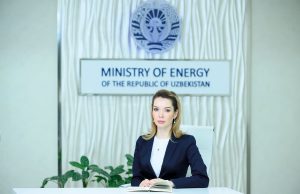Uzbekistan on the Path to Becoming Carbon-Neutral

Advisor to the Uzbekistan Ministry of Energy: Elmira Berkmurodova
In the race to become carbon-neutral, it is useful to look at where the race began. In Uzbekistan, a nation rich in natural gas, it began with nearly all energy requirements — 96.75 percent in 2019 — being met by fossil fuels.
From that perspective, the goal of net-zero by 2050 looks intimidating, if not impossible. But Uzbekistan is on the way to making the impossible at least probable.
In just over a year, it has set a series of ambitious goals for a fundamental transformation of the national energy mix. Chief among them is a shift to renewables. From almost a standing start, the country is planning to build a renewables sector generating a minimum of 25 percent of its energy needs. This is despite a fast-growing population and an even faster-growing economy, demanding greater energy.
“In Uzbekistan, the average citizen consumed well under 10 percent of that: about 1,850 kWh. As incomes rise, so does energy use.”
It is worth comparing low-income Uzbekistan with high-income Norway to illustrate the point. Despite its North Sea oil wealth, Norway has domestically relied on a different source of energy: water. Hydroelectricity provides as much as two-thirds of Norway’s primary consumption — and has done so for many years. In 2020, the average Norwegian consumed 26,500 kWh in electricity. In Uzbekistan, the average citizen consumed well under 10 percent of that: about 1,850 kWh. As incomes rise, so does energy use.
That is Uzbekistan’s challenge. By the end of the current decade, most forecasts indicate its population will surpass those of Ukraine and Poland, making it the second-largest of all the nations once dependent on, or part of, the USSR. It expects to graduate to middle-income status, with an increasingly affluent middle class expecting modern kitchens, air-conditioning and all the comforts of modern life.
There is one more challenge, or opportunity: to reduce the consumption of natural gas from 16.5 to 12.1 billion cubic meters by 2030 — and to use domestically produced gas for conversion into polymer products with high added value and export potential. This is an important component in Uzbekistan’s national industrial policy.
The nation is also hard at work upgrading transport systems to reduce waste and introducing smart metering for home and industrial power and gas consumption. Gas production and processing are also being modernised to minimise waste.
When you do the math, it becomes clear that other sources of energy are needed — and to stick to the Paris Agreement commitment to reduce greenhouse gas production by 10 percent by 2030, those new sources cannot be hydrocarbon-based.
Any visiting tourist can attest to Uzbekistan’s fine weather. On average, 320 days a year are essentially cloudless. In the three decades since independence, it has been so busy searching underground that the Sun’s potential has been overlooked.
That is now changing, as is the national attitude to the forceful winds that blow across plains and through valleys. Over the coming decade are plans for five GW in wind power and seven GW in solar generation. Independent power producers are being invited to enter into power purchase agreements for wind, solar and biogas production. Hydroelectric production is being expanded too, with 35 new plants planned along with modernisation of 27 existing facilities.
On August 27, the country’s first industrial-scale solar photovoltaic power plant — with a capacity of 100 MW — was commissioned in the Karmaninsky district of Navoi by Masdar (UAE). The facility is expected to produce enough power for 31,000 households and save 160,000 tonnes of CO2 emissions each year.
Another 100 MW solar power plant will soon be commissioned in the Samarkand region. It is being built in public-private partnership with the French company Total.
In all, some 16 power-purchase agreements have been signed over the past year, most of them for renewables projects. The forecast is now for electricity production to double by 2030.
What once seemed impossible is now looking entirely achievable.
You may have an interest in also reading…
Marketable Skills Set Young Women on Path to Prosperity in Nepal
Vocational training programs for young women, 16-24, in Nepal are giving them gainful employment, economic independence and bringing trust in
Asia Pacific’s Innovation Boom: Technological Titans are Emerging
Go east, young entrepreneur… The Asia Pacific region is a driving force in global innovation. Comprising a mix of established
Kuala Lumpur: ‘The Next Big Thing’ in Asia-Pacific Business Circles
It is Asia’s best-kept secret: business insiders are shunning the cost and congestion of Asia’s mega-cities and plumping for Kuala



















































































